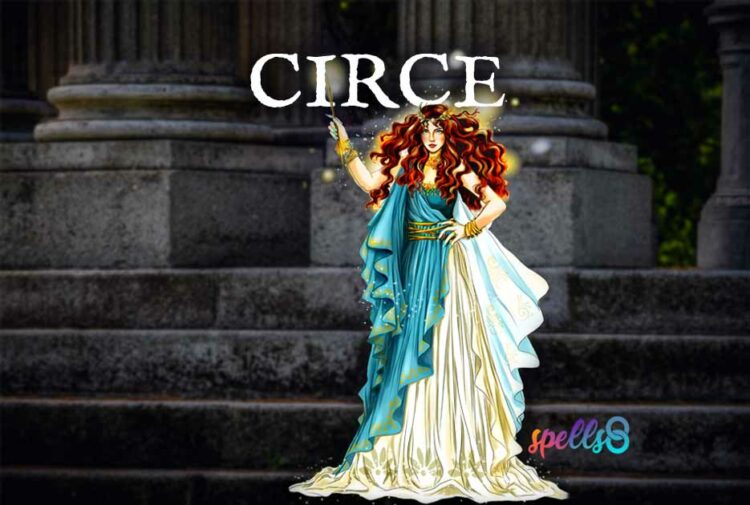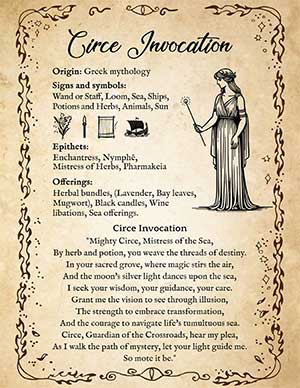Among the myriad deities of Greek mythology, Circe stands out as a captivating sorceress. Known for her deep knowledge of potions and herbs, Circe’s tales are woven into the fabric of ancient stories, including her memorable role in Homer’s Odyssey.
As a figure who blurs the lines between the divine and the mortal, Circe embodies the transformative power of magic. Her legacy continues to enchant those who explore Greek myths, offering insights into the ancient world’s understanding of magic, power, and transformation. Let’s delve into the ways Circe has been honored throughout history and how she can be celebrated in modern practice.
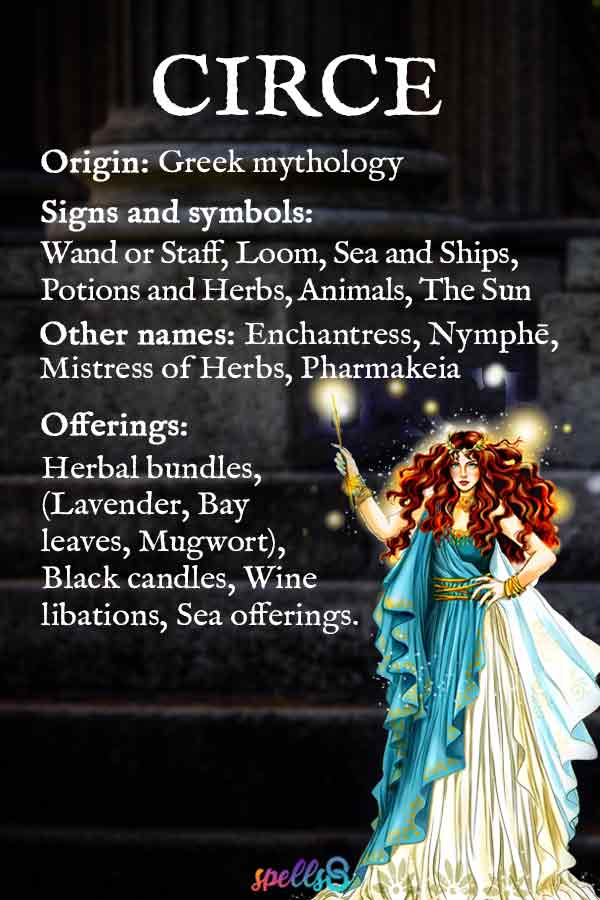
Circe, daughter of the sun god Helios and the ocean nymph Perse, embodies the intertwining of celestial and terrestrial realms. Her abilities to transform humans into animals highlight her as a deity of magic and metamorphosis, akin to figures from various mythologies who hold sway over the natural and supernatural.
Working with Circe
Engaging with Circe, much like connecting with any Goddess, involves an exploration of her stories, titles, and associated symbols. This introduction provides a foundation for understanding Circe’s essence and how to incorporate her into personal pagan practices. Through acknowledging her mythological background, unique powers, and the rich symbolism surrounding her, all seekers can forge a deeper connection with this enchanting figure of ancient Greek lore.
Circe Grimoire Page
Add this page with symbols, correspondences and an invocation to Circe to your Book of Shadows. Print and download this page for free here: Grimoire page: Circe Invocation.
🖨️ Get more pages to complete and organize your magical grimoire here: Printable Pages for your Book of Shadows
- Mythology
- Symbols of Circe
- Titles and Epithets of Circe
- Signs of Circe
- How to Worship Circe as a Goddess
- Further reading
Mythology of Circe
Circe is uniquely positioned within Greek mythology as a figure of immense magical prowess, often identified as the daughter of Helios, the god of the sun, and Perse, an ocean nymph, which places her among the divine yet connects her closely to the earthly realm. Her heritage embodies the fusion of celestial brilliance and the mystique of the deep sea and water magick, underscoring her dual nature as both nurturer and destroyer.
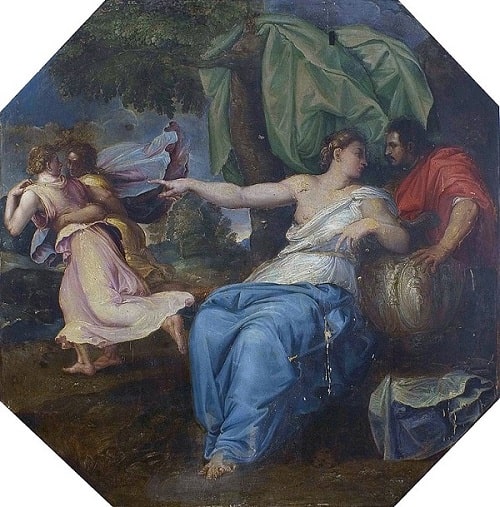
Renowned for her residence on the island of Aeaea, Circe’s mythology is rich with tales of transformation and enchantment. The most famous of these stories is her encounter with Odysseus in Homer’s Odyssey. Circe, a powerful sorceress, initially captivates Odysseus and his crew with her magic, turning them into swine.
Warned by Hermes and equipped with the protective herb moly, Odysseus confronts Circe and resists her spells, compelling her to return his crew to human form. Fascinated by his defiance and with a nudge from the gods, Circe shifts from foe to friend. She hosts Odysseus, offering crucial advice and revealing the challenges he faces, including a journey to the Underworld, thereby illustrating her vast wisdom and supportive role in his saga.
Circe’s mythological narrative is further enriched by her connections to other deities and mortals. Aside from her encounter with Odysseus, Circe is also renowned for her involvement in the myth of Jason and the Argonauts. As the heroes journeyed to find the Golden Fleece, they came upon Circe’s island, Aeaea, seeking purification. Circe, being the niece of Medea, another key figure in the quest, purified the Argonauts for the murder of Apsyrtus, Medea’s brother, whom they had killed during their flight.
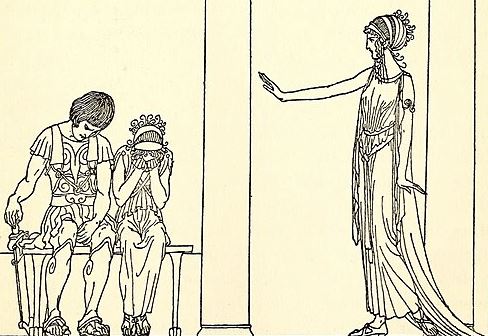
This act of purification allowed the Argonauts to continue their quest without the stain of bloodshed hindering their progress, showcasing Circe’s complex nature as both a harbinger of transformation and a conduit for cleansing and renewal in the ancient myths.
Throughout her myths, Circe challenges the boundaries between the human and divine, revealing the potent and often perilous intersection of fate, desire, and the supernatural. Her legacy in Greek mythology is a testament to the enduring fascination with the themes of transformation and the liminal spaces where the known and the unknown meet.
Symbols of Circe
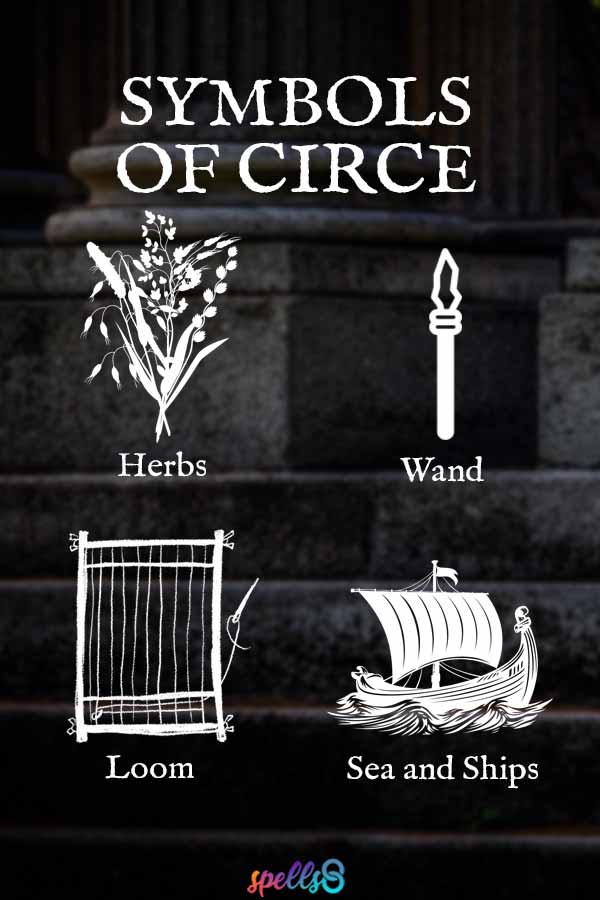
Circe’s mythology is rich with symbols that reflect her complex nature and the themes prevalent in her stories. Unlike Brigid’s symbols, which are deeply rooted in the cycles of nature and domesticity, Circe’s symbols often pertain to magic, transformation, and the manipulation of the natural order.
Wand or Staff: As a sorceress, Circe is frequently depicted with a wand or staff, emblematic of her power to transform and control the elements around her. This tool signifies her authority in the realm of magic and her ability to command the forces of nature, bending them to her will.

Potions and Herbs: Circe’s extensive knowledge of potions and herbs is a fundamental aspect of her mythology. These items symbolize her mastery over the art of transformation and healing, as well as her connection to the earth and its hidden powers. Her use of potions to transform Odysseus’s crew into swine is one of the most iconic examples of her abilities.

The Loom: In some myths, Circe is described as working at a loom, weaving enchanted tapestries. This symbol represents the idea of fate and destiny being woven together, with Circe as the weaver of life’s complex threads. It underscores her role in shaping the futures of gods and mortals alike.

Ships and the Sea: Circe’s presence on Aeaea and her birth from a sea nymph deeply intertwine her with the ocean’s vast energies. Ships navigating its unpredictable waves symbolize her journey between benevolence and vengeance, reflecting her control over both creation and destruction, akin to the sea’s nurturing and ferocious aspects.

The Sun: As the daughter of Helios, the sun god, Circe is also symbolically connected to the sun. This association underscores her divine heritage and the inherent power it bestows. The sun symbolizes enlightenment, clarity, and the revealing of truths, aspects that align with Circe’s revelations to those who seek her wisdom.

Together, these symbols form a rich tapestry that reflects Circe’s multifaceted character. They highlight her dominion over magic and transformation, her deep connections to the natural and divine realms, and her pivotal role in the tales of Greek mythology.
Titles and Epithets of Circe
The name Circe itself carries significant weight in Greek mythology, derived from the Greek “Kirke,” which can be translated to mean “bird” or to signify a circle, hinting at her encompassing, encircling nature and perhaps her transformative powers. Circe’s titles and epithets further illuminate her complex character and her dominion over magic and transformation:
- Φαρμακεία (Pharmakeia) – Meaning “sorceress” or “one who uses potions.” This term captures her expertise in magical potions and herbs, defining her ability to transform humans into animals and perform other magical deeds.
- Νύμφη (Nymphē) – Meaning “nymph.” In some texts, Circe is referred to as a nymph, emphasizing her beauty and perhaps her connection to nature, as nymphs were often associated with particular natural features.
- Ἡλίου θυγάτηρ (Hēliou thygatēr) – Meaning “daughter of Helios.” This epithet underscores her divine parentage and connection to the sun god Helios, indicating her place within the divine lineage and her inherited power.
- The Enchantress: Emphasizes her control over magical spells and her ability to change forms, defining her role in mythology.
- Mistress of Herbs: Acknowledges her expertise in the use of plants for magic and medicine, reflecting her deep connection to the earth.
- Sovereign of Aeaea: Denotes her rule over the magical island of Aeaea, marking her as a significant figure in her own right within her mythological tales.
- Queen of Sorcery: Emphasizes her preeminence in the realm of magic, celebrating her as the paramount sorceress within Greek mythology.
Signs that Circe is Calling You

Circe, the sorceress of Greek mythology, communicates her presence in subtle and mystical ways. If you feel drawn to her, consider it a sign to explore a deeper connection.
- Set up an altar for Circe: Include symbols of her power such as a representation of the sun, the sea, herbs, or a circle to signify her name. Tend to it daily, and consider offerings of herbs known for their magical properties, such as mugwort or bay leaves.
- Light candles: Choose colors that represent her aspects, such as gold for her solar heritage or blue for her connection to the sea. Be attentive to any sensations, sounds, or visions that arise during meditation or dreams, as these could be Circe’s way of reaching out.
- Engage in Magical Practices: Circe’s energy can be tapped through the practice of witchcraft and magic. Crafting spells, potions, or engaging in divination can act as devotional activities to draw her closer.
- Creative Acts: Given Circe’s role as an enchantress who transforms, creative acts like writing, especially spells or poems, and crafting can be a form of worship and a way to open channels of communication with her.
- Meditation and Dreams: Dedicate time to meditate on Circe’s essence and invite her into your dreams. This can facilitate visions or messages from her, guiding you on your path.
Circe’s calling is a journey into the mysteries of nature, magic, and the self. If you feel drawn to her, it’s an invitation to explore the depths of your own power and the mysteries of the world she represents.
How to Worship Circe
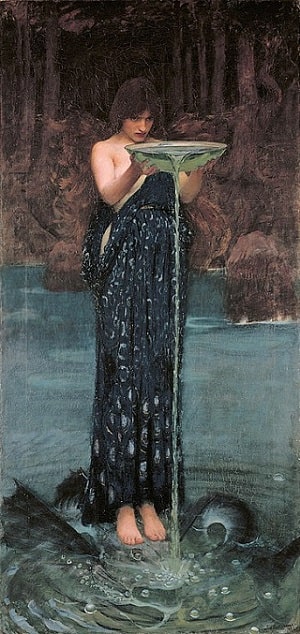
Circe, the sorceress of Greek mythology, beckons those interested in the deeper, transformative aspects of magic. Her worship transcends specific times, inviting engagement with the cyclical nature of life and personal evolution.
- Embrace Transformation: Circe’s essence is deeply tied to change and transformation. Embrace personal growth and changes, seeing them as opportunities to connect with her power.
- Purify and Prepare: Just as Circe offered purification to those who sought her out, consider rituals of cleansing for yourself and your space. This can create a receptive environment for her energies.
- Celebrate Her Myths: Engage with the stories of Circe through reading, storytelling, or enacting rituals that commemorate her tales, especially those highlighting her abilities to transform and to guide.
- Seasonal Celebrations: While not tied to a particular season, recognizing the Wheel of the Year and aligning your practices with the natural world can be a form of honoring Circe, given her connection to the earth and its powers.
Worshipping Circe involves recognizing and honoring the complexities of her nature—her wisdom, her capacity for transformation, and her deep connections to the magic that permeates the world. It’s an invitation to explore the depths of your own power and the mysteries of the universe.
Circe Correspondences
- Element: Water and Earth
- Food: Wine, honey, herbal teas
- Plants: Aconite, belladonna, mugwort, yew, willow
- Herbs: Mandrake, hemlock, vervain, cinnamon
- Animals: Hawks, wolves, lions, pigs
- Gems: Moonstone, amber, opal, sapphire
- Colors: Deep blue, gold, purple, black
- Planet: Moon
Offerings to Circe & Altar

Suitable offerings for Circe include: Wine, Honey, Fresh herbs, Olive oil, Incense, Small cakes or breads, Pomegranates, Sea shells.
Crafting offerings for Circe is a way to honor her profound knowledge of magic and transformation. These gifts, made with intention, can strengthen your connection to this powerful sorceress.
- Herbal bundles: Circe, being a mistress of herbs, appreciates bundles of herbs, especially those with magical properties. Tie together lavender, mugwort, or bay leaves as a gift of respect and devotion.
- Candles: Lighting candles, particularly in deep blue or black, can be an offering to invoke Circe’s transformative power and illuminate the path to deeper wisdom.
- Wine libations: Pouring out wine as a libation honors Circe’s Greek heritage and acknowledges her as a deity of pleasure and transformation.
- Sea offerings: Given Circe’s island dwelling, offerings related to the sea, such as shells or saltwater, connect to her realm and her mastery over nature.
- Magic circles: Creating a circle with stones or drawing one in the earth can be a symbolic offering to Circe, referencing her name’s possible link to the circle and her encompassing, protective power.
These offerings, when placed on an altar dedicated to Circe, serve not only as tokens of reverence but also as a means to cultivate a deeper relationship with her, inviting her wisdom and strength into your life.
Invocations and Prayers to Circe
Call upon Circe, the divine enchantress of Aeaea, to weave her magic into your life with this invocation:
“Mighty Circe, Enchantress of Aeaea,
Daughter of the Sun and Mistress of the Sea,
By herb and potion, you weave the threads of destiny.
In your sacred grove, where magic stirs the air,
And the moon’s silver light dances upon the sea,
I seek your wisdom, your guidance, your care.
Grant me the vision to see through illusion,
The strength to embrace transformation,
And the courage to navigate life’s tumultuous sea.
Bless me with your sorcery, that I may find my power,
In the depths of the earth and the vastness of the sky,
Help me to bloom, to flourish, to tower.
Circe, Guardian of the Crossroads, hear my plea,
As I walk the path of mystery, let your light guide me.
So mote it be.”
Further Reading
- Mythology: Timeless Tales of Gods and Heroes by Edith Hamilton
- Circe by Madeline Miller
- The Witch in the Western Imagination by Lyndal Roper

